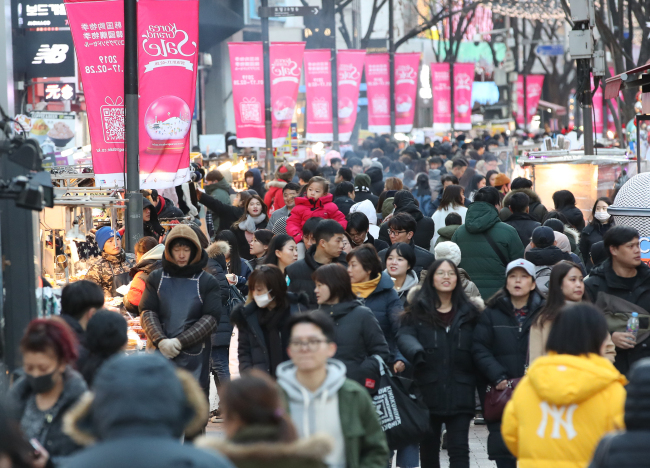 |
The Myeong-dong area of Seoul bustles with tourists during 2019’s Korea Grand Sale, an annual tourism festival that promotes shopping and tourism in the city. (Yonhap) |
Myeong-dong, one of the largest retail districts in Korea, was the only area among the world’s top 10 global shopping streets that saw an average rent drop on-year in 2019, according to global real estate consulting firm Cushman & Wakefield.
According to a recent report published by the consulting firm, the annual average rent in the Myeong-dong district came in at $862 per square foot, down 1.5 percent on-year. In order to rent a store area of 30 pyeong, or 99 square meters, for instance, it costs -- based on the average exchange rate between Korean won and US dollar of 1,166 won last year -- around 1.07 billion won per year.
In 2018, Seoul ranked eighth among the 10 global shopping streets. The list included Hong Kong’s Causeway Bay, New York’s Upper 5th Avenue and London’s New Bond Street, which topped the list in that order.
In 2018, Hong Kong’s Causeway Bay, where the average rent reached $2,745 per square foot, took the crown as the most expensive place to rent a retail store in the world from New York’s Upper 5th Avenue at $2,250. Until 2017, Upper 5th Avenue was the most expensive shopping district for five straight years.
New Bond Street came third with $1,714, followed by Paris’s Avenue des Champs Elysees at $1,478, Via Montenapoleone of Milan with $1,447 and Ginza of Tokyo at $1,251.
Vacancy rate of commercial buildings was also high last year, especially in the third quarter, according to the Korea Appraisal Board, a government agency that evaluates real estate properties.
The vacancy rate for midsized and large buildings in the July-September period stood at 8.9 percent, the highest since 2016 when the rate was 11.2 percent.
The number of Chinese and Japanese tourists also dropped in a significant manner. From January to November last year, the number of Chinese tourists fell 26.1 percent on-year while the figure for the Japanese dropped 12.1 percent during the same period.
Market analysts attributed falling consumption and the accelerating transition to e-commerce to the rent price drop in the Myeong-dong area last year.
“Building owners usually keep their spaces empty even when rent prices drop,” Cho Young-moo, a researcher at LG Economic Research Institute, was quoted as saying by Yonhap News Agency.
“The high vacancy rate and falling rent indicates that the market is now in a downturn.”
Cushman & Wakefield, however, said the Myeong-dong area has recently been regaining its vigor as it is seeing an increase in the number of foreign tourists.
“Myeong-dong is still one of the top 10 shopping streets despite the drop in the rankings,” said Dan Kim, head of the real estate consulting firm, adding that the area will continue to see large flagship stores open down the road.
By Kim Young-won (
wone0102@heraldcorp.com)








